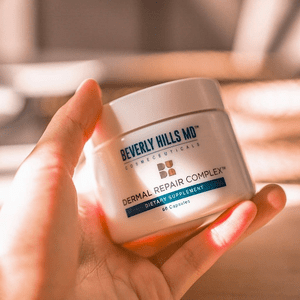Changes in skin texture and suppleness is one of the first visible indications of aging. As the years pass, it slowly begins to lose its elasticity and its ability to return to its normal state, leading to loose and saggy skin. While there is no way to stop gravity from doing its job, you can certainly slow its effect through lifestyle changes as well as surgical or nonsurgical treatments. Depending on the areas you want to address, you can, with the help of a licensed professional, opt for either or both for sustained results.
What Causes Loose Skin?
Firm skin has elasticity, which means it can stretch and snap back easily. So, when skin loses this ability it starts to sag. A combination of factors can cause loose and saggy skin. Some of them are rapid weight gain followed by rapid weight loss, reduced elasticity and collagen triggered by UV exposure, lack of exercise, and certain connective tissue disorders, such as Ehlers-Danlos syndrome and cutis laxa.
How to Tighten Loose Skin Naturally?
If you are looking for natural ways to tighten loose skin, you can consider a few methods after talking to a healthcare professional.
Exercise
One way to tighten loose skin is regular and targeted exercise. Working out and building your muscles can boost collagen, maintain skin elasticity, and firm skin over time. Even activities like yoga and pilates, swimming, dancing, and lifting weights can help.
Hydrate
Lack of water or fluid intake can cause dehydration, which can exacerbate the appearance of wrinkles and loose skin. It can also cause excess sweating when the body tries to cool itself down, and result in further loss of water.
Eat Healthy
Another natural way to reduce loose skin is eating foods rich in omega-3 fatty acids, antioxidants, and collagen. A few nutrition-rich options are spinach, quinoa, berries, fish, beef, tofu, and nuts.
Read more: Anti-aging skin care routine
Nonsurgical Methods to Tighten Loose Skin
A dermatologist or cosmetic surgeon may recommend and perform nonsurgical procedures to help reduce loose skin.
Nonsurgical Radiofrequency
This method uses radiofrequency heat waves to target the dermis and stimulate collagen production. You may start to see results after the first procedure; however, its full effects set in within six months. If done right, nonsurgical radiofrequency can last about two to three years.
Ultrasound
Ultrasound works on the deeper layers of the skin. You may notice subtle lifting and tightening within two to six months post-treatment. For sustained results, you can consider a micro-focused ultrasound treatment plan.
Laser Treatment
This procedure targets the epidermis, which is the outer layer of the skin. You will need three to five sessions to start seeing visible results.
Firming Products
Certain gels, patches, and creams contain skin-boosting compounds, such as hyaluronic acid, hydrolyzed collagen, collagen boosters, and vitamins A and B, that can tighten loose and saggy skin. You can consider investing in a few products depending on the areas you want to tackle. The Beverly Hills MD Rapid-Lift Advanced Neck Serum, for instance, offers dual-action effects; it smoothens the appearance of neck wrinkles while firming up the skin around the neck region.
Read more: How to prevent wrinkles
Surgical Methods to Remove Saggy Skin
In extreme cases, nonsurgical methods might not always work. In that case, surgical methods become a viable option. But they are often expensive, so it is best to consult a healthcare professional and get the low-down to make an informed decision.
Facelift
This is a cosmetic surgical procedure to lift and tighten facial tissues, which helps get rid of jowls and reduce facial drooping. While the effects of a facelift are not permanent, they are long-term.
Brachioplasty
This procedure, also known as an arm lift, involves reshaping the upper arm. It helps get rid of extra skin and fatty tissue and is usually recommended for post-rapid natural or surgical weight loss.
Panniculectomy
Excess skin and fatty tissue in the lower abdominal area can be removed with the help of a panniculectomy. While the procedure helps contour the abdominal area and reduce excess skin, it does not necessarily tighten the muscles, as in the case of a tummy tuck.
How to Choose the Right Skin-Tightening Method for You?
Your unique needs, skin condition and texture, and budget will be deciding factors in choosing the right skin-tightening method. You may also need to adopt a combination approach, i.e., natural and surgical methods, to reduce loose and saggy skin. Ultimately, a healthcare professional can help you determine the right skin-tightening method.
Popular Skin-Tightening Products
Beverly Hills MD Rapid-Lift Advanced Neck Serum
It contains Vin-Uplift™, a skin-lifting system that can tighten the skin around the neck region. It also contains pullulan, which helps retain moisture and make the skin appear plump.
No7 Protect & Perfect Intense Advanced Serum
This product contains hydrating ingredients, such as pro-retinol, hyaluronic acid, and collagen peptides. Some of these act as humectants, i.e., draw moisture into the skin, and emollients, i.e., maintain moisture levels, keeping the skin plump and moisturized.
Isdin Hyaluronic Concentrate
This serum has hyaluronic acid and peptides that keep the skin supple and moisturized. It is perfect for dry and mature skin types.
Beverly Hills MD Dermal Repair Complex
This supplement is packed with skin-boosting ingredients, such as hydrolyzed collagen for wrinkle reduction, saw palmetto, a DHT blocker for skin elasticity, and vitamins A and B to promote skin cell turnover.
Ren Clean Skincare Bio Retinoid Youth Cream
This is a plant-based retinol with ingredients like Bidens pilosa and red microalgae. It is recommended for sensitive skin and to promote supple skin.
These strategies and products can help tighten loose skin; however, select an option unique to your needs after talking to a certified healthcare professional. If you opt for nonsurgical and surgical methods, ensure you eat well and exercise regularly (post-recovery) for long-lasting results.
FAQs
Can You Really Tighten Loose Skin Without Surgery?
Yes! Loose skin can be tightened even without surgery. Natural remedies like exercising, eating healthy, and hydrating, and nonsurgical methods, like ultrasounds, laser treatment, and nonsurgical frequency, can tighten loose and saggy skin. That said, excess loose skin caused by rapid weight loss may require surgical intervention.
How to Tighten Skin on the Face?
The skin on the face can be tightened with natural, nonsurgical, and surgical methods. However, it is best to consult a healthcare professional before opting for a skin-tightening method, even if it does not involve surgery. This is because not all nonsurgical procedures may be suitable for mature skin.
How to Tighten Loose Skin on the Stomach?
Rapid weight loss, pregnancy, and aging can cause the skin around the stomach to sag. In case of minor sagging, you can incorporate weight training exercises into your routine. These build muscle mass and reduce the appearance of saggy skin. A meal plan rich in omega-3 fatty acids and protein from foods like fatty fish, nuts, and meat can increase collagen production and maintain skin elasticity. In case of excess loose skin, you can opt for radiofrequency or panniculectomy once a healthcare professional gives you the go-ahead.
How to Reduce Loose Skin?
Loose skin can be caused by lifestyle, genetic, and environmental factors. You can reduce it by focusing on lifestyle changes like getting regular exercise and eating well. You can also opt for ultrasound treatments, topical creams, neuromodulators, chemical peels, or surgery.
How to Tighten Your Face Naturally at Home?
Face tightening is possible by boosting collagen production and circulation, both of which can be achieved by eating nutrient-dense food and massaging your face in small, circular motions—avoid downward strokes, as they can worsen skin that is already beginning to sag. Besides that, facial massage might not be the best option if you have had neuromodulator (injectibles) treatment done to your face.
Additionally, having a skin care routine with hydrating products like Pureance Lift & Glow can help. Moisturize daily and invest in a good sunscreen to prevent further damage.













There are no comments yet